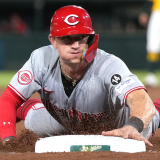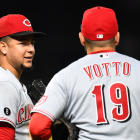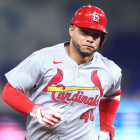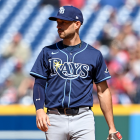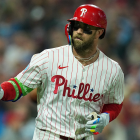
MLB hot stove: Landing spots for Joey Votto, Luis Castillo, Sonny Gray and more as Reds continue sell-off
If the Reds want to keep cutting payroll, they still have several players to trade

One week into the 2021-22 MLB offseason, the Cincinnati Reds have been the most active team in baseball, and not necessary for a good reason. The Reds have started cutting payroll, first by trading catcher Tucker Barnhart to the Tigers for a fringe prospect, then by letting lefty Wade Miley go to the NL Central rivals Cubs on waivers. Those moves saved the team $1.5 million over what they would have spent had they just bought out Barnhart's ($7.5 million) and Miley's ($10 million) club options.
"Trading Tucker was a very difficult decision," Reds GM Nick Krall told reporters, including Bobby Nightengale of the Cincinnati Enquirer, following the Barnhart trade. "Having been drafted and developed by the Reds, our entire organization has a connection to him, and our fans love him. But going into 2022, we must align our payroll to our resources and continue focusing on scouting and developing young talent from within our system."
Aggressive cost-cutting is nothing new for the Reds, who essentially gave Raisel Iglesias away last offseason to avoid his $9.125 million salary. Cincinnati went 83-79 in 2021 and was in the postseason race most of the season, plus the Reds had the fourth-highest scoring offense in the National League (4.85 runs per game). It's disappointing them to see them tighten the purse strings after they contended much of the year and play in a division that is far from dominant.
The cost-cutting may not end with Barnhart and Miley. The Reds are willing to discuss any player making significant money, reports MLB Network's Jon Heyman, and MLB.com's Jon Morosi adds ace Luis Castillo is already drawing trade interest. No surprise there. Castillo is one of the game's most talented pitchers and would help to every rotation.
What other players could move as part of Cincinnati's efforts to "align our payroll to our resources?" Let's take a look.
Contract status: $8 million in 2022
Two years ago the Reds took a three-year, $21 million roll of the dice on Shogo Akiyama, who authored a .303/.392/.471 batting line with 20 home runs in his final season with the Seibu Lions in Japan. In his two years with the Reds, the 33-year-old Akiyama has hit .224/.320/.274 without a single home run in close to 400 plate appearances. He's been overmatched, particularly against velocity. Akiyama is a good center fielder with some speed, but he offers zero offense, and an $8 million price tag for a fourth (or even fifth) outfielder is too rich for just about every team.
Potential landing spots: Phillies, Mets, Rangers, Rockies. Krall insists he does not want to attach players or prospects to undesirable contracts to dump money. In that case, he has close to no hope of moving Akiyama.
Contract status: $7.6 million in 2022 (projected) and arbitration-eligible in 2023
Cincinnati's No. 1 trade chip is their ace, who shook off a slow start this past season to post a 2.73 ERA with 144 strikeouts in his final 22 starts and 135 1/3 innings. Castillo, 28, brings upper-90s velocity, arguably the best changeup in the sport, and the ability to miss bats and get ground balls to the table. He is elite and he comes with two years of control. His trade value is significant, even with the Barnhart and Miley moves signaling the Reds are prioritizing finances over the best possible baseball move. The bidding war for Castillo would be fierce.
Potential landing spots: Every contender, really. Any team with designs on contending in 2022 will check in on Castillo. That list of teams should include the Reds, though it's pretty clear now winning is taking a backseat to bringing payroll down.
Contract status: $10 million in 2022 and $12 million club option for 2023 (no buyout)
Other than Castillo, Sonny Gray might be Cincinnati's best hope of swinging a trade that clears significant dollars and brings a solid haul in return. The 32-year-old has been good more than great around various non-arm injuries the last two seasons (back, groin, ribs) and he generally doesn't pitch deep into games, but Gray has posted a solidly better than league average ERA every year of his career except 2016 and 2018, and teams will take 140 above-average innings over 180 average innings these days.
Potential landing spots: Angels, Astros, Braves, Cardinals, Dodgers, Giants, Mariners, Padres. Gray is good enough and affordable enough to fit with most teams, and the club option means he's not necessarily a one-year pickup either.
Contract status: $5 million in 2022 (projected) and arbitration-eligible in 2023
An analytics darling, Tyler Mahle would be an extremely popular trade candidate if the Reds go ahead and make him available. He boasts the spin rates teams crave, a high strikeout rate, and the ability to suppress hard contact. Mahle turned 27 in September and is not a true ace, but the ingredients are there for him to be this offseason's Joe Musgrove, the guy who finally takes that next step after years of showing impressive measurables but inconsistent performance.
Potential landing spots: Angels, Astros, Blue Jays, Braves, Cardinals, Dodgers, Giants, Mariners, Rays, Red Sox, Yankees. A good starting pitcher with a chance to be great and team control beyond 2023? Yeah, Mahle will be very in-demand on the trade market. If the Reds trade him and Castillo, we might as well just call this what it is: a full-blown rebuild at the alter of cost-cutting.
Contract status: $16 million in 2022, $18 million in 2023, and $20 million club option for 2024 ($4 million buyout)
Heel and foot injuries limited Mike Moustakas to 62 unproductive games in 2021. He's only two years removed from a 35-home run season, and you can squint your eyes and say Moustakas will be better in 2022 with good health seeing how he turned only 33 in September (and not, say, 35 or 36), but at that salary? Hard to see another team taking a chance without the Reds eating money or kicking in some kind of sweetener. Moustakas has shown steady declines in his strikeout rate, chase rate, and hard-hit rate, which are often signs of reduced bat speed.
Potential landing spots: Blue Jays, Nationals. Again, it's hard to see a trade coming together unless the Reds eat money or attach a prospect(s) to Moustakas. That's a lot of money for a player who has exhibited signs of decline.
Contract status: $11 million per year from 2022-24 plus $15 million club option for 2025 ($2 million buyout)
Things have gone so bad, so fast for Eugenio Suárez. Two years ago he mashed 49 home runs and was one of the top sluggers in the game. Now he's among the worst players in baseball. Suárez, who is still only 30, posted minus-0.6 WAR in 2021, though to be fair, it's not his fault the Reds asked him to play shortstop early in the season after ignoring the position over the winter. He was a defensive disaster there. The bat has taken a significant step back too, even if Suárez can still hit 30-plus homers. A batting average around .200 with 30-plus homers can work if you draw a ton of walks and win Gold Gloves like Joey Gallo, but not if you don't walk much or contribute defensively. Suárez has negative trade value at the moment.
Potential landing spots: None. Cincinnati's best hope is a bad contract for bad contract trade that takes the $35 million they owe Suárez the next three years and redistributes it in a more team-friendly way. What that bad contract for bad contract trade could look like, I'm not sure. I mean, Suárez isn't that expensive.
Contract status: $25 million per year from 2022-23 plus $20 million club option for 2024 ($7 million buyout)
Hard to imagine Joey Votto playing for another team, isn't it? Votto turned 38 in September and he just had a resurgent 36-homer season, tying the second highest total of his career, with his typically strong on-base percentage. He is a hitting savant, capable of making adjustments to remain productive even while his physical skills naturally erode with age. The list of players who you'd feel comfortable projecting to be above-average contributors from ages 38-39 is very short, but Votto is on it. He's still an impact hitter, a good defender, and a clubhouse leader.
Potential landing spots: Blue Jays, Red Sox, Yankees. Gosh, Votto going home to Toronto would be such a fun story. He would have to share first base and DH duty with Vladimir Guerrero Jr., and Teoscar Hernández would have to play the outfield full-time, but it can work. The money limits the potential landing spots for Votto, but the three big-market AL East teams stand out as suitors.
Contract status: $6.8 million (projected) and arbitration-eligible in 2023
Simply put, Jesse Winker is one of the best pure hitters in the game. He has power, he draws walks, and he doesn't strike out excessively. Winker was a deserving All-Star this season and, at age 28, he is right smack in his prime. This guy would not look out of place as the No. 3 hitter on a World Series contender. The downside is Winker is a brutal defensive outfielder. One of the worst in the sport. He's a DH, through and through. Fortunately, his bat more than plays at the position.
Potential landing spots: Blue Jays, Mariners, Rays, Twins, White Sox. The upcoming collective bargaining agreement is expected to implement the universal DH, which would create a few more potential suitors for Winker.
Various relievers
The Reds had bullpen problems most of the season -- the bullpen was their downfall, really -- so there wouldn't seem to be a huge market for their relievers, but individually, they have a few interesting pieces. Righty Luis Cessa ($1.2 million projected) is a slider machine who has experience in every role. Lefty Amir Garrett ($2.2 million projected) has elite stuff, albeit with a home run problem. Righty Lucas Sims ($1.2 million projected) has found a home in the bullpen as a high strikeout slider specialist. All are effective and have control behind 2022. Their projected salaries may seem like a drop in the bucket, and they are, but keep in mind the Reds just moved Barnhart for a fringe prospect to avoid the $500,000 buyout of his club option. No amount is too small to dump.
Potential landing spots: Every team. There will always be a market for cheap, controllable relievers. Sims in particular should draw interest as a high-leverage option.























